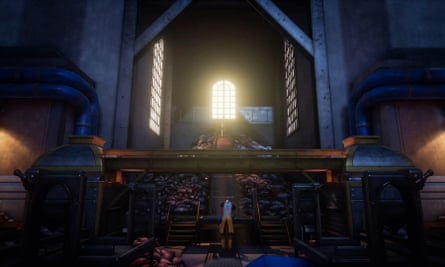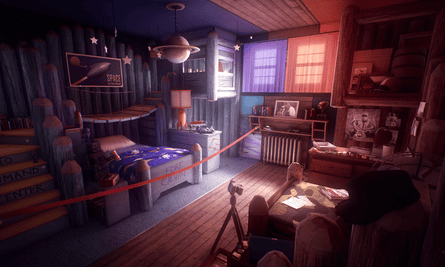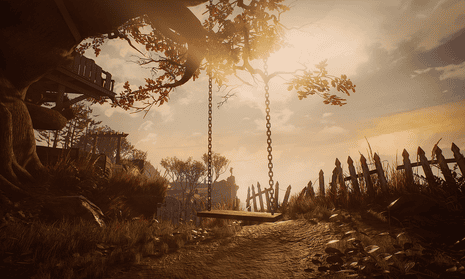What Remains of Edith Finch is a game about storytelling and a masterclass in characterisation. Although it bears all the hallmarks of games like Gone Home or Dear Esther with its spooky waterside property, its readable letters and journey entries, and its lack of a “run” button, the game soon strays from the familiar paths trodden by those seminal “walking simulators”. Instead, What Remains delivers a collection of whimsical tales that leap deftly from one genre to another without ever losing the thread at the heart story.
The eponymous Edith is the last remaining member of the cursed Finch family, who have all died in strange circumstances, some of them at a young age. She is returning to the family home to find out what happened to them all. After each Finch death, the person’s bedroom was sealed up, never to be used again, resulting in a rambling, crooked tower of a house, with rooms tacked on here and there over time. In this way, the house acts as a grounding hub for the game, a visual metaphor for the messiness and chaos of life and a physical manifestation of the Finch family tree.

At first glance, this seems like a dramatic departure from developer Giant Sparrow’s, first indie hit Unfinished Swan. Gone is the interesting ink-splash gameplay mechanic, gone is the stark white fairy tale city, and in their place is more conventional, beautifully rendered visuals. But scratch the surface and What Remains shares the same themes of folkloric wonder, as well as the storybook structure of its predecessor. At times, a character climbs into books, in scenes reminiscent of The Neverending Story or Alice in Wonderland.
Giant Sparrow seamlessly transports the player from one character to another, shifting viewpoints and time periods through three generations of a family. To describe any of the stories within the game is to say too much, as each chapter is so distinct from the last in terms of gameplay, aesthetic and setting. The only thing every episode shares is the first-person perspective and simple move, look and click controls. Only in one brief flying and swimming sequence did the interface feel like a hindrance; otherwise it is beautifully integrated. The analogue stick is used to turn a key in a lock, or wind up a music box and turn the pages of book. The effect is tactile rather than testing.
The interior of the house is a character in itself, and to learn more about it, you have to explore. The level of detail means that really understanding a space takes more than a moment’s pause, but nothing in the world is surplus: the clutter has a narrative purpose. A wheelchair with an oxygen bottle attached tells one story, as does the modern stairlift in this old house. Even the takeaway boxes and the dishes still smeared with food have a tale to tell. And then there are the books.
The Finches were obviously big readers because books are stacked everywhere. The titles vary depending on whose room you’re in – in one you may find Treasure Island sitting beside a book on Japanese manners, in another you’ll see a favourite family cookbook lying open on the table, as if it has been left mid-read. And the game itself acts as a book, with text sitting along the top of a gate or wrapping around the back of an armchair, as Edith narrates. Words may dissolve or letters scatter in the wind, depending where the story travels.

Each beautifully detailed bedroom is a mausoleum for a Finch relative, but all the doors are locked, so the path inside is often ingenious and disorienting. A hatch in the floor of one room leads to a tunnel, which then leads to a ladder in another and then Edith climbs through a picture to find the story within. As she explores the rooms, she’s transported into tales of the characters’ last moments. These stories-within-a-story play with ideas of the unreliable narrator, as well as the blurring of fiction and reality. It’s a game about the stories families tell each other and how memories become fiction and then history, before morphing into their own kind of truth.
One episode splits the controls between the “real” world and an imagined one, in a story that is designed to resonate with gamers in particular. In another, 10-year-old Molly is the narrator of a Lovecraftian trip that transports the player into different bodies. It should be nightmarish, but the episode evokes the ghoulishness of nursery rhymes such as There Was an Old Lady Who Swallowed a Fly, so anyone expecting jump scares and horror will be disappointed. Instead, there are monsters under the bed, magical storms that conjure up The Wizard of Oz, a brilliant homage to Weird Tales comics and an incredible water sequence that evokes the wonder and whimsy of Disney’s Fantasia.
This tragic family saga uses literature as its inspiration, with more than a touch of the magical realism of Gabriel García Márquez, as well as the more obvious influences of Lovecraft and weird fiction. If Wes Anderson made a game it would feel like What Remains of Edith Finch (maybe with more pink), with its eccentric cast of characters and fanciful events that always fit together as a cohesive whole.
What Remains of Edith Finch is a game that succeeds in recreating the childhood joy of reading a book and being utterly transported into its pages, only to reach the end and realise it’s not real. It will touch the heart of all but the most soulless of gamers.
Annapurna Interactive; PS4 (version tested)/PC/Mac; £15; Pegi rating: 16+

Comments (…)
Sign in or create your Guardian account to join the discussion